Standard 7.2: Competing Information in a Free Press
Give examples of how a free press can provide competing information and views about government and politics. (Massachusetts Curriculum Framework for History and Social Studies) [8.T7.2]
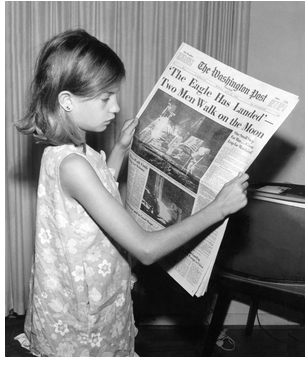
Figure \(\PageIndex{1}\): A girl holds The Washington Post of Monday, July 21st 1969, by Jack Weir | Public domain
FOCUS QUESTION: How does a free press provide competing information about government and politics?
Standard 7.2 looks at how a free press provides information about government and politics to people, both historically and in today's digital age. In many countries around the world, the press is not free and people receive one side only of a story about a topic or issue—the side the government wants published. A free press, by contrast, presents topics so people get wide-ranging and informed perspectives from which they can make up their own minds about what candidates and policies to support (explore the site AllSides to see how news is presented differently depending on the platform).
Central to free press is the role of investigative journalism that involves the "systematic, in-depth, and original research and reporting," often including the "unearthing of secrets" (Investigative Journalism: Defining the Craft, Global Investigative Journalism Network).
7.2.1 INVESTIGATE: History of Newspapers, Then and Now
Historians cite Ancient Rome's Acta Diurna (Latin for "daily proceedings" or "public acts and records") as the first newspaper. Carved on stone or metal and posted in public places, these publications shared the news of legal proceedings and court decisions as well as births, deaths, and marriages. Modern newspapers follow from Gutenberg's invention of the printing press in the early 1600s. Go here for an overview and learning plan on the History of Newspapers from the University of Minnesota Libraries.
More than a century ago, the newspaper was how people in the United States learned about what was happening in the world. It was the social media of the time. In 1900, more than 20,000 different newspapers were published in this country; 40 papers had over 100,000 readers. The viewpoints of these papers reflected different political parties and political philosophies, were published in many different languages besides English, and were written for both general and specialized audiences (Breaking the News in 1900, TeachingHistory.org). As historian Jill Lepore (2019, p. 19) noted, "The press was partisan, readers were voters and the news was meant to persuade."
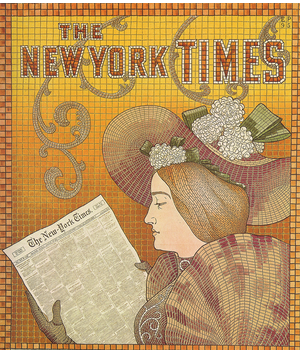
Figure \(\PageIndex{2}\): Detail of a New York Times Advertisement - 1895 by Edward Penfield | Paris, Musée des Arts Décoratifs, public domain
Changing Outlets for the News
Today, print newspapers are being replaced by many different kinds of television and digital news outlets: TV cable and broadcast news, YouTube, Apple News, Twitter, podcasts, digital magazines, blogs, and more.
Go here to view Today's Front Pages from 500+ newspapers worldwide.
In Merchants of Truth, her study of the recent history of four major news outlets (BuzzFeed, Vice, The Washington Post, and The New York Times), journalist Jill Abramson (2019) detailed how print newspapers, the "guardians of truth" of times past, became caught in financial crisis at a time when disinformation was becoming very easy to share online. News, Abramson (2019, p. 4) wrote, "had become ubiquitous in the digital age, but it was harder than ever to find trustworthy information or a financial model that would support it." In today's media world, Abramson (2019, p.10) wonders what type of organization will bring "quality news" -- what she defines as "original reporting, digging in to find the real story behind the story" -- to people who are less likely to read print newspapers and more likely to encounter fake and false information online.
News Deserts and the Decline of Local Newspapers
While online and television news expands, a Brookings Institution researcher concluded that more than 65 million Americans live in what can be called "news deserts"—counties with only one or no local newspapers (visit Local Journalism in Crisis for a map of local newspapers in the United States). The Washington Post has reported that as of 2020, a quarter of U.S. local newspapers (some 2,200 papers) have ceased publishing. You can view the 2021 status of local newspapers with this interactive map (The Lost Local News Issue, November 30, 2021).
The decline of local newspapers has been happening for decades. Between 1970 and 2016, more than 500 daily newspapers went out of business, and in 2016, one-third of the nation's remaining newspapers reported laying off employees (Lepore, 2019). That same year, in 2016, Google made four times the advertising revenue of the entire American newspaper industry combined (Lemann, 2020, p. 39). A 2018 study found that just 2% of American teenagers read a print newspaper regularly—the report was subtitled "the rise of digital media, the decline of TV, and the (near) demise of print" (Trends in U.S. Adolescents' Media Use, 1976-2016).
Sources of Political News
Broadcast news outlets have become the main source of political and education news for most Americans, with Fox News (16%) and CNN (12%) being the most frequently named sources. News viewing has also become more intensely partisan politically. An overwhelming number of Republican or Republican-leaning adults named Fox News as their main source of political news; Democrats and Democrat-leaning adults named MSNBC as their main source (Pew Research Center, April 1, 2020).
An added complexity are the ways that TV news outlets cover political news. Analyzing the frequency on which members of Congress appear on cable and broadcast news, researchers found that the most airtime goes to those with the most extreme views (Journalist's Resource, January 17, 2021). While extreme viewpoints may drive ratings for news programs, such bias in coverage contributes to political polarization, dislike of opposing viewpoints, and distrust in institutions of government.
All these developments raise a fundamental question: How is the decline of print newspapers and the rise of digital media changing the roles of the press in our society?
Media Literacy Connections: Objectivity and the News from All Sides
Print newspapers, television news shows, online news sites, and social media platforms do not all present the news in the same way or even as objectively agreed-upon and accurate facts.
Rather, as demonstrated in the 2018 Rand Corporation report Truth Decay, the news we read and view is a combination of facts and opinions, neutrality and bias, packaged to appeal to different audiences (young, old, affluent, working-class) and, in some cases, partisan political perspectives (Democrats, Republicans, progressives, conservatives). The same event is likely to be covered differently by Facebook, Fox News, MSNBC, The New York Times, and the Washington Post.
In the following activities you will practice evaluating the news from different sides; that is, from different points of view and contrasting political perspectives.
Suggested Learning Activities
- Construct a news timeline
- Develop an interactive multimodal history of newspapers in the United States (using Timeline JS, Adobe Spark, LucidPress, or Google Drawings).
- Publick Occurrences, which appeared in Boston, September 25, 1690, was the first Newspaper published in the British Colonies. The colonial governor did not approve and issued a ban on future publication; all copies—save one now in the British Library—were destroyed. The Pennsylvania Packet and Daily Advertiser was the first daily newspaper in America, beginning on September 21, 1784.
- Covering America: A Narrative History of the Nation's Newspapers. Christopher B. Daly (University of Massachusetts Press, 2018)
- A History of Newspaper: Gutenberg's Press Started a Revolution, The Washington Post (February 11, 1998)
- Early American Newspapering, from Colonial Williamsburg (Spring 2003)
- History of Newspapers in America, ThoughtCo. (May 31, 2018)
- Newspapers Today Fact Sheet, Pew Research Center: Journalism & Media (June 13, 2018)
- Top Ten U.S. Daily Newspapers (January 4, 2019)
- Create a graphic history of the Newsboys Strike of 1899
- The Newsboys (or Newsies) were young girls and boys who sold newspapers to make money for their families. They worked long hours for a little as 30 cents a day during the 1800s and early 1900s until child labor laws were passed.
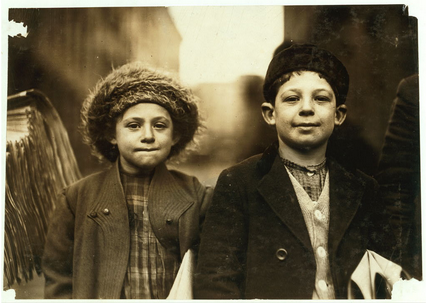
Figure \(\PageIndex{3}\): Girl and Boy Selling Newspapers, Newark, New Jersey (1909) by Lewis Hine | Library of Congress, public domain
The History of the Black Press
The Black Lives Matter movement has focused attention on many aspects of African American life, including the Black Press, which in 2019 consisted of a collection of 158 publications in 29 states and the District of Columbia serving some 20 million readers online (Ford, McFall, & Dabney, 2019, p. 1). Throughout its history, the Black Press has reported stories and covered issues that were neglected or ignored by mainstream White-controlled media.
The Black Press has been, and still is, a central voice of Black experience. Its impact, particularly through its advocacy for civil rights, voting rights, school desegregation, and equal justice, has extended beyond African American communities to the wider society where it has helped change attitudes and propel change.
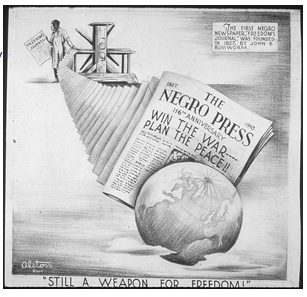
Figure \(\PageIndex{4}\): 116th Anniversary of the Negro Press - with caption and reference to the founder of the first Negro Newspaper, John B. Russworm
by Charles Henry Alston, 1943 | U.S. National Archives, public domain
Here are key milestones in the history of the Black press:
- John B. Russwurm and Samuel Cornish were the founders of Freedom's Journal (1827-1829), the first newspaper owned and operated by African Americans.
- Frederick Douglass founded The North Star abolitionist newspaper in 1847. Explore Frederick Douglass Newspapers, 1847 to 1874 from the Library of Congress.
- Mary Ann Shadd Cary was an activist, writer, abolitionist and the first Black woman to publish a newspaper (The Provincial Freeman) in North America in 1853.
- The Chicago Defender, founded in 1905 by Robert S. Abbott, became one of the nation's most influential Black newspapers before World War I.
- The Philadelphia Tribune, founded by Christopher James Perry, Sr., in 1884 is America’s oldest and largest daily newspaper serving the African-American community (aalbc.com).
- In 1892, Ida B. Wells began a newspaper, The Memphis Free Speech, that exposed and denounced the lynching of African Americans in America, the beginning of her career as an activist and journalist. Learn more at this Ida. B. Wells historical biography wiki page.
You can learn more about the history of the Black Press at African American Media Today: Building the Future from the Past, a report from Democracy Fund.
Suggested Learning Activity:
- Option 1: Conduct a critical media literacy analysis of a present-day Black-owned newspaper and a non-Black-owned newspaper of your choosing. Use the Teacher and Student Guide to Analyzing News & Newspapers to guide your analysis. Share your findings in a video, podcast, or blog.
- Option 2: Examine articles from historical Black-owned newspapers. What are common themes and issues addressed in these articles? Are these themes and issues still prominent today? Why or why not? Share your findings in a TikTok or Snapchat video.
Online Resources about Newspapers
- Lesson and Unit Plans
- Participate in "History Unfolded" Project
- History Unfolded: U.S. Newspapers and the Holocaust, a project of the United States Holocaust Memorial Museum in Washington, D.C. asks students, teachers, and history buffs what was possible for Americans to have known about the Holocaust as it was happening and how Americans responded.
- Participants look in local newspapers for news and opinion about 38 different Holocaust-era events that took place in the United States and Europe, and submit articles they find to a national database, as well as information about newspapers that did not cover events.
7.2.2 UNCOVER: Investigative Journalists and Whistleblowers: Nellie Bly, Ida Tarbell, Ida B. Wells, Upton Sinclair, Rachel Carson, and Modern Examples
Investigative journalism is one of the ways that a free press provides truthful information to people. Investigative journalism "involves exposing to the public matters that are concealed–either deliberately by someone in a position of power, or accidentally, behind a chaotic mass of facts and circumstances that obscure understanding. It requires using both secret and open sources and documents" (Mark Lee Hunter as cited in UNESCO, 2015, para. 1).
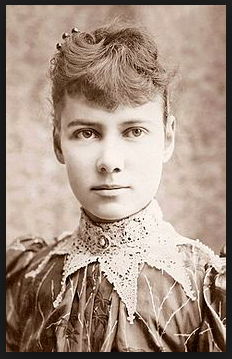
Figure \(\PageIndex{5}\): Nellie Bly (Pseudonym of Elizabeth Jane Cochrane) by H. J. Myers, circa 1890 | Library of Congress, public domain
The United States has a history of courageous investigative journalists willing to "speak truth to power" by informing the public of intolerable conditions and corrupt practices by citizens and companies.
- Ida Tarbell, journalist and muckraker who wrote in 1904 about the monopolistic practices of John D. Rockefeller and the Standard Oil Company;
- Nellie Bly, a journalist who in the late 1880s and 1890s documented the plight of working girls in factories, the everyday lives of Mexican people, and life within New York's mental institutions where she went undercover to expose the corruption and mistreatment of the inmates;
- Ida B. Wells was a Black woman activist and journalist who became an activist, journalist and anti-lynching crusader and one of the most important civil rights pioneers of the early 20th century;
- Upton Sinclair, who documented horrible sanitary health practices in Chicago's meatpacking facilities at the turn of the 19th century - his book The Jungle was published in 1906;
- Rachel Carson, who revealed the widespread unsafe use of pesticides in her book Silent Spring (1962), helped to launch the modern environmental movement.
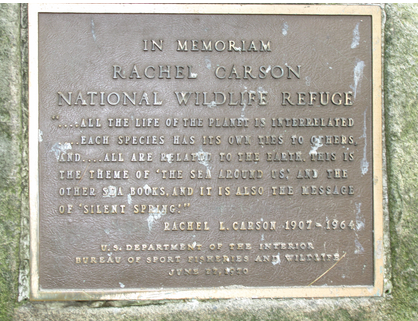
Figure \(\PageIndex{6}\): Plaque at the Rachel Carson National Wildlife Refuge in Wells, Maine, by Captain Tucker
Recent Examples of Investigative Journalism and Whistleblowers
In recent decades, the work of reporters and writers demonstrate the enormous impacts that investigative journalism can have in society: David Halberstam earned a Pulitzer Prize for revealing the lack of truth in U.S. claims of military success during the Vietnam War; Seymour Hersh uncovered the 1968 My Lai Massacre of Vietnamese civilians by American troops; in 1971, Daniel Ellsberg released the Pentagon Papers, top-secret documents about the American War in Vietnam. In recent years, the #MeToo Movement has exposed widespread sexual misconduct toward women by prominent men in business, the media, and government (visit How investigative journalism sparked off the #MeToo movement).
In early 2020, a group of digital whistleblowers made the world aware of the coronavirus outbreak in China (The Digital Radicals of Wuhan). Here are more examples:
The Pandora Papers
In October 2021, the International Consortium of Investigative Journalists (ICIJ) released its Pandora Papers report, a massive study of more than 11.9 million financial documents showing how elites around the world secretly hide billions of dollars in offshore accounts to avoid taxes, investigators, and accountability. Offshore accounts are havens for money outside a person's home country.
The list of those involved included 130 people listed as billionaires, leaders of countries on every continent, and 14 currents heads of state or government, including Jordan King Abdullah II, four African nation presidents, and the presidents of Ukraine, the Dominican Republic, and Ecuador.
The Facebook Files
Also in October 2021, The Wall Street Journal released the Facebook Files, its investigative report on the social media company's exploitative business practices that emphasized profit over privacy and truth. The report detailing how Facebook engaged in "whitelisting," so high-profile users were exempt from the rules governing everyone else on the platform. The company ignored evidence that Instagram's promotion of ideal body types is harmful to the self-images of teenage girls. Further, Facebook emphasized the publishing of emotionally charged political material, encouraging extremism of the type that contributed to the January 6, 2021 Insurrection at the nation's Capitol.
The reporting by The Wall Street Journal was further supported by whistleblower Frances Haugen, a former Facebook employee, who appeared before a Congressional committee to add details to the story.
Suggested Learning Activities
- Create a comic, graphic, or poster on the life of an investigative journalist
- Review the historical biography pages below for Nellie Bly, Ida Tarbell, Upton Sinclair, and Rachel Carson, and develop a summary of their life and impact as investigative journalists.
- Highlight important investigations, obstacles faced, and results achieved.
- Design a statue for an investigative journalist
- A statute for Nellie Bly is planned to be added to Roosevelt Island in New York City. In 2017, the city had 150 statutes of men and only 5 of women.
- Design a statute for Nellie Bly, or another investigate journalist, using physical materials (e.g., tape, cardboard, paper, PlayDoh), then recreate that design in a 3D modeling program, such as Tinkercad, so it can be 3D printed.
- Create a sketchnote on the History of Whistleblowing
- Read: Why Do Some People Choose to Blow the Whistle?
- How do whistleblowers get the courage to speak out and face the backlash they often receive for their actions?
- Use the following resources to learn more about whistleblowing and its role in a free press.
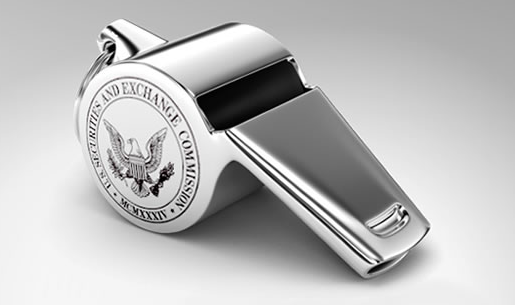
Figure \(\PageIndex{7}\): Symbol of the Office of the Whistleblower | Public domain
Online Resources for Investigative Journalism and Whistleblowing
- BOOK: Crisis of Conscience: Whistleblowing in a Age of Fraud. Tom Mueller. Atlantic Books, 2021
- Lesson plans
- The Paradise Papers: A Lesson in Investigative Journalism, a full learning plan from the Pulitzer Center. The Paradise Papers document the off-shore financial holdings and tax havens of world leaders and politicians. In 2021, this investigation was expanded to the Pandora Papers.
- The Jungle, Muckrakers, and Teddy Roosevelt
- Additional reading
7.2.3 ENGAGE: Does Every Citizen Need to Be His or Her Own Investigative Journalist?
On June 17, 1972 a night-time break-in and burglary occurred at the Democratic National Headquarters in the Watergate Hotel in Washington, D.C. - an event which ended up having immense national and historical significance. The break-in was done by a group of former FBI and CIA agents called the "Plumbers," all with strong ties to the Republican Party and committed to the re-election of President Richard M. Nixon. The "Plumbers" sought to bug telephones and find political dirt on the Democratic Party.
Labeled the Watergate Break-In, the event was revealed through years of investigative journalism by the press, notably reporters Bob Woodward and Carl Bernstein of The Washington Post, and uncovered abuses of power and illegal deeds that led to Richard Nixon’s resignation as President. Nixon is the only man ever to resign the Presidency.
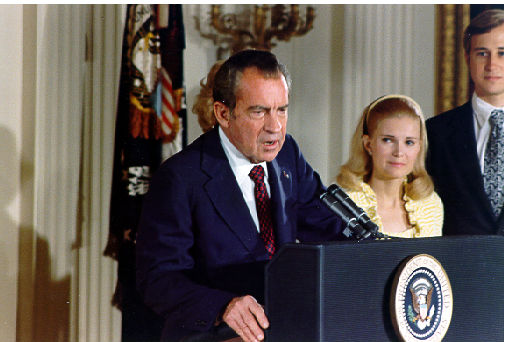
Figure \(\PageIndex{8}\): Richard Nixon Farewell Speech to the White House Staff, August 8, 1974 with daughter Julie and son-in-law David Eisenhower looking on | White House Photo Office Collection, Gerald Ford Library, Public Domain
Investigative journalism plays an essential role in a democracy, but the work of investigation is long and difficult. It takes time and money to track down sources, verify facts, and locate the truth. Unlike Watergate, not every case of wrongdoing and corruption is exposed; many times the guilty are never held accountable for their actions. The decline of newspapers, locally and nationally, means there are fewer investigative journalists on the job.
In today's media-driven society, gossip and celebrity journalism often get more attention than investigative journalism. There are numerous television shows, websites, and print magazines devoted to reporting on celebrities and their lifestyles. While the lives of the rich and famous may be interesting, reporting on those individuals generally does not give "people the information they need to make better decisions about their lives and society" (Kovach & Rosenstiel, 2014).
In their book The Elements of Journalism, journalists Bill Kovach and Tom Rosenstiel declared that every citizen must become their own investigative journalist - constantly evaluating all the news and information they receive from multiple sources for reliability and truth. Certainly everyday people cannot function like newspaper reporters whose full-time job is finding and reporting the news. But everyday people, including students in schools, can be what Kovach and Rosenstiel call "journalist/sense makers" who use the information they get from professional media and print journalists to make their own decisions by separating facts from fictions, knowledge from rumor and truth from propaganda and lies.
Media Literacy Connections: Investigative Journalism and Social Change
Investigative journalists have helped to create social and political change throughout history, from improving worker conditions in the early 1900s (the early muckrakers' work of Ida Tarbell, Ida B. Wells, Upton Sinclair, and others) to releasing the Pentagon Papers (Daniel Ellsberg, 1971) to exposing sexual harassment in the 2010s (#MeToo) to 2021's revelations about Facebook's involvement in the spread of misinformation online. Given journalism's potential to affect social change, what contemporary issues would you investigate?
In this activity, you will act as an investigative journalist as you explore a political topic of interest.
Suggested Learning Activities
- Engage in civic action
- Investigate a local community issue - collecting data from multiple sources - and present the findings as an investigative journalist.
- Based on your findings, propose action by individual people and local government to create change.
- Set a plan to achieve a personal goal
- What steps are you going to take to be your own investigative journalist?
- Record a video or podcast
- Provide ideas and information to inspire other students to become informed and critical readers of the news.
Online Resources about Investigative Journalism and Watergate
- Lesson plan:
- Interactive resource:
- Additional reading:
Standard 7.2 Conclusion
In this standard, INVESTIGATE summarized the history of newspapers, the current decline of print journalism, and the rise of digital news. UNCOVER presented the histories of prominent late 19th century and early- to mid-20th century investigative journalists - Nellie Bly, Ida Tarbel, Upton Sinclair, and Rachel Carson - each of whom used newspapers to expose corruption in government and improve society. ENGAGE explored the question "Does every citizen need to be her or his own investigative journalist?", starting with the role of the Washington Post newspaper in the Watergate Scandal that led to President Richard Nixon's resignation in 1974—events that have taken on added relevance against the backdrop of Donald Trump's actions related to Russian interference in the 2016 Presidential election and the 2019-2020 impeachment inquiry over the withholding of military aid to the nation of Ukraine.









